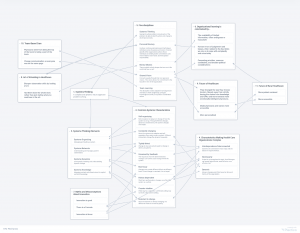https://www.plectica.com/maps/SQ5HYJ4AD
1. What is Systems Thinking?
- A complex and dynamic way to approach problem solving.
2. What are some of the common systems characteristics?
- Self-organizing, constantly changing, tightly linked, governed by feedback, non-linear, history dependent, counter-intuitive, and resistant to change.
3. What are the elements of Systems Thinking?
- Organizing, networks, dynamics and knowledge.
4. Identify the characteristics that make health care organizations complex systems.
- Interdependence/interconnectedness, non-linearity, dynamic
5. Describe the five disciplines that promote organizational learning.
- Systems thinking, personal mastery, mental models, shared vision.
6. Explain why organizational learning often proves difficult in practice and discuss strategies for promoting organizational learning and innovation.
- Organizational learning is constrained by the availability of limited information, often ambiguous or inaccurate.
- Human errors of judgement and biases, often related to the heuristics we rely on to cope with complexity and uncertainty
- Competing priorities, resource constraints, and broader political considerations
7. Myths and misconceptions about innovation
- Innovation is good, there is a formula, innovation is linear.
8. Art of attending in healthcare
- Sharpen observation skills of doctors by having them look at art and think about the whole story.
9&11. Future of healthcare and rural healthcare
- Healthcare needs to be more personalized, patient-centered and accessible. This change will ideally start in rural areas and work its way into other healthcare systems.
10. Team-base care
- Changing communication between physicians and those at the top so everyone is working on the same level and is on the same page.

Fantastic job, Kimberly!